Last Updated on 29/11/2023 by Dochlaggie. Post first published on November 9, 2020.
As I have been involved in breeding Pomeranians since 1975, I am able to explain in detail everything about important Pomeranian pregnancy stages and breeding Pomeranian dogs.
Important Pomeranian Pregnancy Facts
- Pomeranian females can have a season as early as 6 months of age and may fall pregnant at that age.
- Pom girls under 18 months and senior Pomeranian females should not be bred with.
- Gestation period for Pomeranian is 63 days.
- Your Vet can tell if your Pomeranian is pregnant between week 3 and 4.
Pomeranian Breeding Information
A Pomeranian in heat may fall pregnant while she’s in her first heat cycle. The moment a dog hits puberty (the first heat cycle), she has the ability to conceive. With toy breeds, this can happen when they’re quite young; often around six months of age.
The female dog’s cycle lasts two to three weeks and this is when she’s sexually receptive to male dogs. During this period, there’s a small window of a few days when eggs drop and pregnancy may occur. Most dogs cycle two times per year and it is normal for their cycles to be somewhat irregular.
Even if a tie is unsuccessful, your dog may become pregnant. Lots of dog owners think that they stopped the dog mounting prior to anything actually occurring, but the female may already have been impregnated. A female Pomeranian can be impregnated by two different males and it’s called a “multi-sired” litter.
It’s a possibility because female dogs can have several eggs available for a couple of days. So, if she’s mated by one male, she can be fertilized.
If she’s then mated by another male, a different egg may be fertilized. If a Pom is impregnated by a bigger dog, it can be dangerous for her during the pregnancy and the final delivery. If you take your Pom outside so she can do her business, always check for stray dogs in the area.
Pomeranian Mating Age
Pom females should not be bred at their first season and ideally, first breedings should be delayed until the Pom female is at least 18 months of age.
Older Pomeranian girls in a perfect world also should not be having first litters as 4 years olds, nor should any caring owner consider breeding a senior Pom female.
Conscientious owners will have females desexed and reputable Pomeranian breeders will have suitable facilities for girls in season.
Pseudo-Pregnancy (False Pregnancy)
A pseudo-pregnancy (false pregnancy) is possible and is caused if there’s an imbalance in the prolactin and progesterone hormones. Her belly will grow in size. breast tissue may increase and, occasionally, milk may be produced.
If this happens, talk to your vet. He’ll generally recommend using cold or warm packs to be placed on the female’s mammary tissue to decrease the swelling that would generally subside within three weeks. If it doesn’t, you may need to administer hormone supplements.
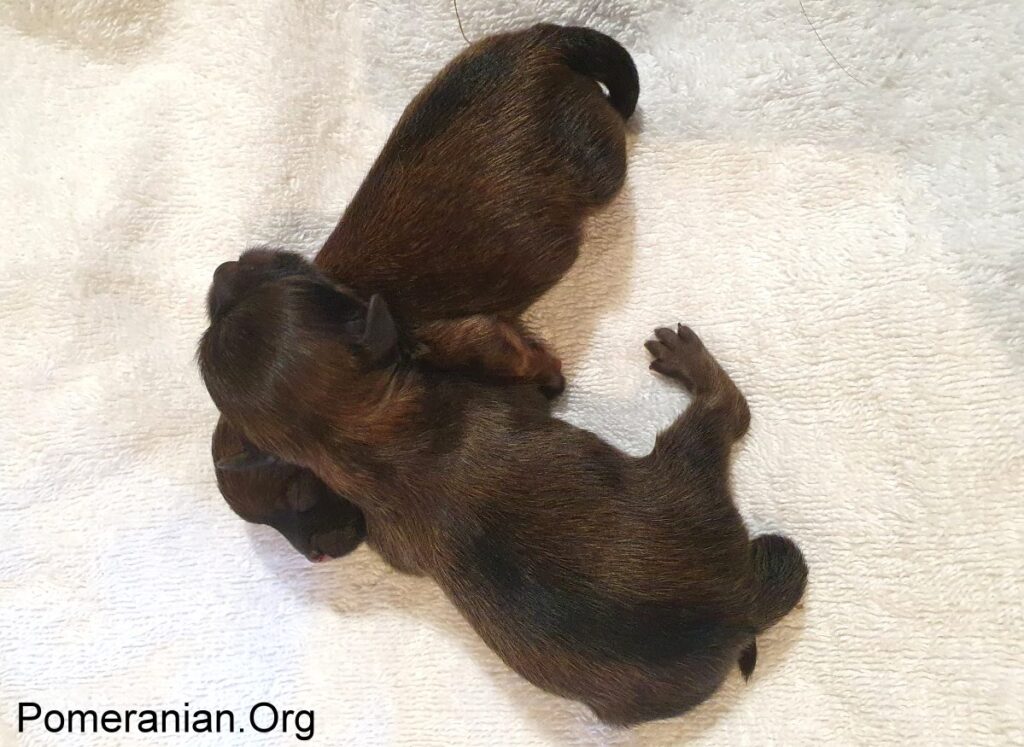
How Many Babies do Pomeranians Have?
A Pomeranian will produce an average litter of between one and four puppies. As a breeder of champion Pomeranians for many decades, I have found the average Pomeranian litter is 3 puppies. Occasionally I have had a girl whelp a large litter of 5 or 6 puppies.
How Long is a Pomeranian Pregnancy?
The average Pomeranian dog pregnancy period or gestation period for Pomeranians is 63 days.
Pomeranian puppies are usually born 61 days after conception. It takes 48 hours for the egg to ripen before the egg will allow penetration of sperm. If your Pomeranian female ovulates on day 11 of her cycle then conception begins on day 13 of her cycle.
Not knowing exactly when ovulation occurs, this Pomeranian gestation chart is as close as you can get to predicting her due date and when Pomeranian labor will commence.
Pomeranian Pregnancy Length
There are numerous elements that may determine the due date including the fact that pregnant Pomeranian mothers carrying large litters may whelp earlier as well as the fact that first-time mothers may whelp later than expected.
Pomeranian Gestation Calendar
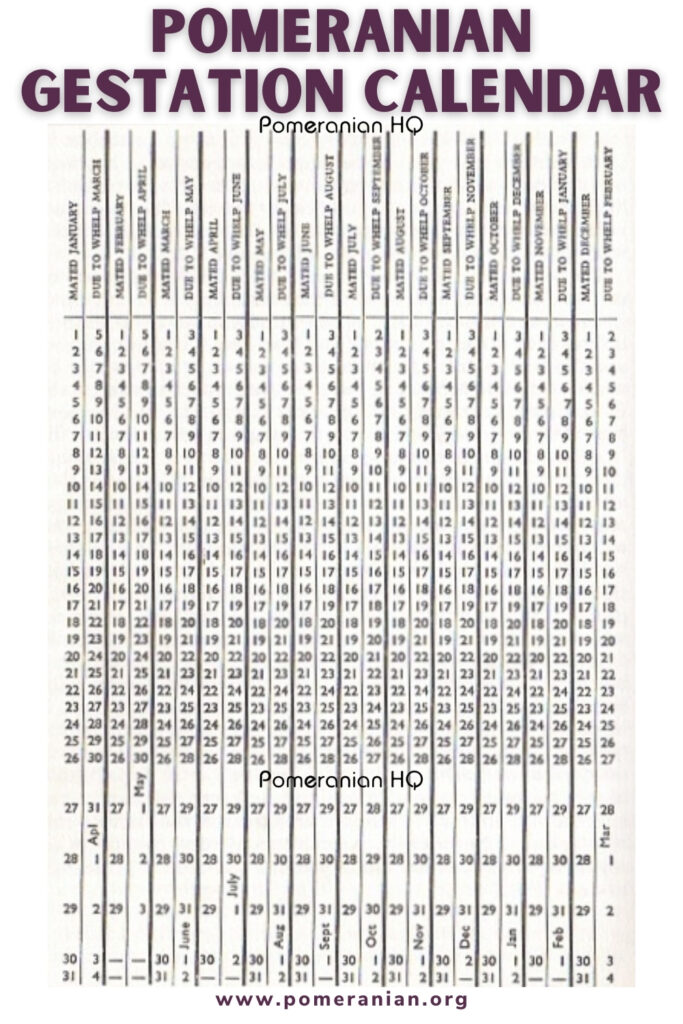
How To Tell If Your Pomeranian Is Pregnant
You count the days from the day of mating as Day 1. The earliest time that you can look for any visible signs of pregnancy, or ask your vet to check, is on Day 22.
Here are the various tests that can be done and when to do them.
- Day 22- 27 – A blood test can be performed to verify pregnancy.
- Day 28 – An ultrasound can be performed to verify pregnancy.
- Day 22 – 28 – The vet can use palpation to determine pregnancy.
- Day 43 – 45 – An x-ray can be taken to confirm pregnancy. However, if you really want to know how many puppies will be born, wait until Day 55 for a more accurate reading.
If you don’t do any of these tests, you won’t know for sure that your Pom is pregnant until Day 28+ when her stomach is larger than normal.
Visiting The Vet is Essential
If you plan to breed two specific dogs, it’s wise to have them undergo a comprehensive barrage of tests so you know they’re healthy and to eliminate any risks of genetic defects in the puppies.
The vet will measure the width of the female’s pelvis to ensure she can give birth naturally. If a Pomeranian pregnancy occurs and it’s not planned, take your dog to see the vet urgently because this can be a serious concern.
Pregnant Pomeranian Symptoms
- Week 1: In the first few days, there won’t be any signs. However, by the end of that week, it’s possible that your female may experience nausea and a reduced appetite as a result.
- Weeks 2 & 3: Depending on the Pom, there will be some early indicators. She may be extra tired. Her stomach may have a slight swelling. Her nipples may appear a little bigger than usual. She may spend more time cleaning herself. During Week 2, she may still have some nausea but that should disappear and her appetite will rebound stronger than ever as she moves into her third week.
- Week 4: She’s blatantly pregnant now. Nipples that may haven’t been protruding until now will do so. Her nipples will be darker and enlarged. Her stomach will be swollen and obviously pregnant. If this isn’t her first pregnancy, her nipples might hang down as they become full of colostrum. Her appetite will be healthy and she may have the tendency to nest.
- Weeks 5 & 6: She is nearing the end of her pregnancy and will be far more tired than before. She won’t be social and will generally want to just rest quietly. A typical pregnancy will last for 63 days. However, it may fluctuate between 58 – 65 days and still be regarded as normal.
Pregnant Pomeranian Diet
You don’t have to be exact in how much food you give your Pom but it’s unwise to either over or underfeed her. She doesn’t need to have her meals increased for a few weeks but her caloric intake should be increased as she transitions into her third week so it’s at an extra 25% of her usual intake.
Many vets recommend feeding her the puppy version of her usual brand of food. It’s often a smart idea to give her meals more often instead of trying to make her eat a larger quantity at her usual feeding times. When she’s nearly ready to go into labor, she may stop eating completely.
Pregnant Pomeranian Weight Gain
During pregnancy in Pomeranians, she’ll increase her weight by 20% of normal. If you’re concerned that she’s either gaining too much weight or not enough, speak to your vet. The pregnant pomeranian belly won’t all be the puppies. It will also be comprised of fluids such as amniotic fluids and water, as well as the amniotic sacs that encase each individual fetus.
Pregnant Pomeranian Supplements
Generally speaking, you shouldn’t give pregnant dog supplements of any kind because they can harm the mother and her litter. Calcium is one of the worst because it has been linked to abnormalities and eclampsia.
However, you may give the dam liquid calcium during labor because it will help with her contractions and if given during a 48 hour period post whelping can be used to help calm a new mother.

After that put your calcium supplements away until the next whelping and instead feed calcium-rich meals to the mother.

Caring For Your Pregnant Pomeranian
Pregnant Pomeranian Exercise
Let your Pom exercise if she desires to do so and at her own pace (unless the vet has advised against it). This will ensure she’s fit and healthy during her pregnancy and more capable of giving birth when the time comes.
Never allow her to jump off a bed, a sofa or anything else where a landing may jar the body. (All Poms shouldn’t do this anyway.) When the last two weeks arrives, and partly dependent on the size of her litter, she may be unable to move around easily and so it’s fine to stop walking her until she’s ready to do so, after birth has happened and she can move around again.
Comfort.
If you have been allowing your Pom to sleep in your bed, set up a proper bed for her because she’ll have powerful nesting instincts. It can be a gated area or a play pen with a high quality dog bed. However, don’t isolate her.
Her bed should be set up in one corner of the main family room. Other dogs, if you have other canine pets and they make your pregnant Pom nervous, put portable baby gates around her resting space.
If you also own the sire, keep them separated from the start of the fifth week. He can return to her once the litter is weaned.
Pomeranian Pregnancy Week by Week
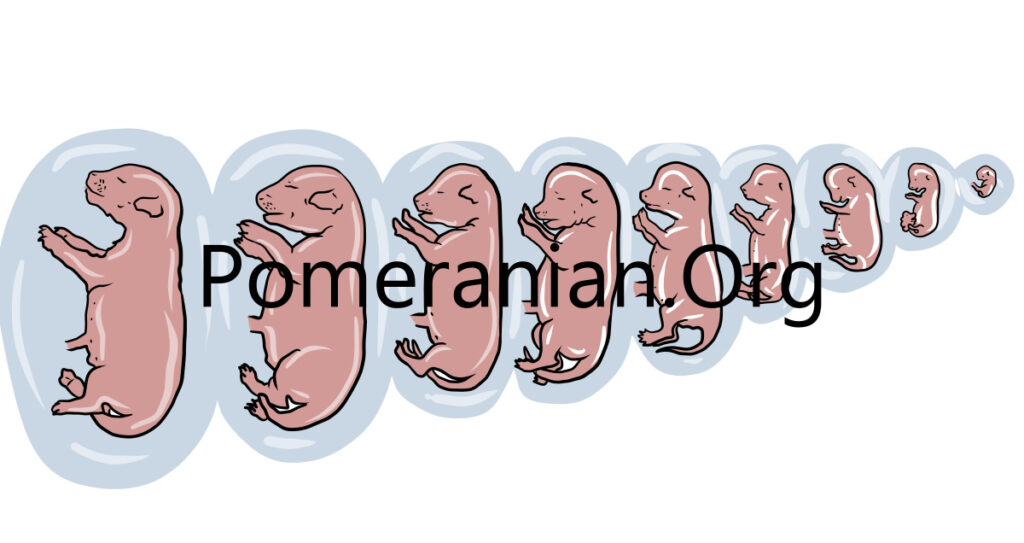
Pomeranian Pregnancy Day 1:
- You need to start making changes from the first day that you notice signs your Pom is pregnant.
- Mark a date on the calendar that is 56 days after the breeding day. By that day, you need to be 100% prepared.
- If possible, take a couple of weeks off work starting from Day 56. Your Pom can’t be left on her own unless you measure her temperature regularly and she’s not at the labour point yet.
- Increase calcium-rich foods in her diet.
Pregnant Pomeranian Symptoms Weeks 1 – 3:
- She may be a little moody. Her vulva may be slightly swollen.
- Don’t feed her medications without talking to your vet.
- Never give her any flea treatment without consulting your vet.
- Avoid vaccinations and worm treatments.
Pomeranian Pregnancy Week 4:
- Your dam is obviously pregnant by then and officially verified by the vet. Her stomach will be swollen and her nipples (including extras) will start to pop up.
- She may have an odourless, clear discharge but this is typical.
- If the dam eats something that’s toxic, the foetuses are more prone to defects. So you need to spend time “puppy-proofing” your entire home as well as any outside area she can access. Take your time and do this right because it will also be good protection once the litter start growing and moving around to explore on their own (when they’re old enough).
- Restrict long walks but you should still take her for short walks each day.
- Change her diet to calcium rich commercial puppy food.
- Feed snack foods that are rich in calcium.
- Feed her more food if she’s still hungry after a normal meal.
Pomeranian Pregnancy Stages Week 5:
- By this stage, the foetuses start looking like puppies, with the development of toes and nails.
- Eyes develop in the open position at first.
- In this week they’ll close and won’t reopen until approx. 10 days after they’re born. Foetuses have stronger resistance to problems with development.
- Keep on with the short daily walks and limit the longer ones.
- Feed more food as required, but don’t allow the mother to become fat.
- Feed her small amounts of cottage cheese and/or yoghurt between main meals.
Pomeranian Pregnancy Calendar Week 6:
- The dam’s nipples keep growing and become darker.
- Her puppies start to develop skin colour.
- Now is the time for preparing her whelping box in a quiet corner of the lounge or other prominently used room where she can sleep or rest and know she’s not isolated.
- Encourage her to go to sleep in this new space but never force her.
- Don’t allow her to run around outside unsupervised. Dams have been known to run and hide so they can give birth on their own.
Pomeranian Dog Pregnancy Period Week 7:
- Give her more food as required.
- Cease any jumping or rough playtime.
Pomeranian Dog Pregnancy Period Week 8:
- If you’re resting with your Pom, you may feel and see movement insider her stomach. You should get ready in case she gives birth early.
- Ring the vet to book an appointment to have the dam scanned to verify the the quantity and sizes of the litter. Day 55 or 56 are the two best days to book.
- Ensure the whelping area is fully set up.
- Create your emergency plan if need to take your Pom to the emergency clinic.
- She’ll be very fussy with what she eats this week, tempt her with small nutritious snacks often during the day.
- Clip the dam’s stomach area free of hair in preparation for pups nursing.
- Give the mother a warm bath and dry thoroughly.
Week 9 (Day 57 Dog Pregnancy to Day 65):
Her nesting behaviour may start or increase at this time.
She may lose her appetite.
Take her temperature 3 – 5 times each day and keep records of the readings in case the vet needs them.
Important Pomeranian Pregnancy Care During This Time:
This should be her daily temperature-taking routine:
- Day 57 dog pregnancy = 3 times per day. Day 58 = 4 times a day. Day 59 = 5 times a day PLUS a sixth time in the middle of the night. Day 60 – During the day every 2 hours. During the night = every 4 hours.
Use Vaseline to lubricate the thermometer, slide it into the rectum 1.5 – 2 inches.
- Commence taking your dog’s temperature at your estimated day 57 of her cycle.
- Record your pregnant Pomeranian temperature in the AM and PM ( ideal time is when the dog is relaxed or even has been asleep – NOT following a run in the yard).
Dog Labor Temperature Chart
Taking your dog’s temperature as well as documenting this may well tell you, within 24 hours, when Pomeranian whelping will probably commence. On numerous occasions, 12-24 hours prior to the decline it may rise higher than it has been in weeks. The following chart can assist you with temperature recording.
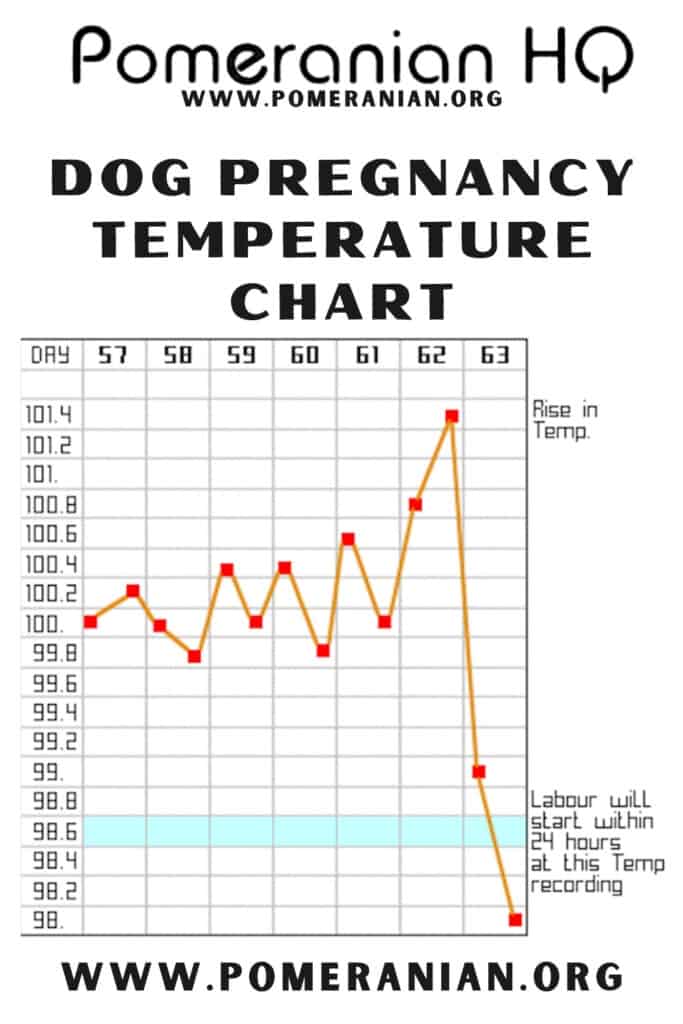
You may possibly observe a large increase in temperature just prior to it dropping. Any temperature recorded lower than 99.2 indicates labor may commence within 24 hours. A Pomeranian dog’s regular temperature fluctuates between 101-102 degrees.
In the final trimester of the Pom pregnancy, the pregnant Pomeranian female may have a temperature of about 100. This is attributed to hormone levels.
Dogs can certainly safely whelp their litters 58 days following conception. After 58 days the pups’ lungs are completely developed and the puppies can easily breathe by themselves.
Pomeranian Pregnancy Care Plan
Preparing the Birthing Area and Whelping Box
The mother-to-be should be accustomed to her whelping box at least 2 weeks prior to her due date. The whelping box should be lined with plenty of clean sheets.
During the birthing process, as the bedding becomes soiled, replace it with clean linen. This space needs to be in a quiet room where she won’t be disturbed by people coming and going or other animals.
You, and perhaps one other helper, are all the human contact your Pom wants at this time. Once the puppies have been born, you need to use a heating pad that can be hidden under a blanket and it should be near a power socket.
Pomeranian Whelping Supplies
You’ll need these items to help you assist your dam to give birth:
Towels, sterilized scissors, dental floss, and a baby’s nasal aspirator (bulb syringe).

Pomeranian Giving Birth Indications
Your Pom will give birth within 24 hours when her temperature falls below a normal reading.
Find a position in which your pet feels comfortable and safe. Using a canine thermometer, ensure it’s well-lubricated and insert it 1.5 – 2 inches into her rectum where it should remain for three minutes.
Her temperature should normally be 38.3C to 39.17 Celsius. If it drops under 37.77C, the 24-hour clock will start.
Urgent Reasons To Ring The Vet:
- If her temperature has been low for 24 hours and she’s crying and/or vomiting but hasn’t given birth.
- If her pregnancy has lasted over 65 days
- If you know there’s more than one puppy but only one has come out in a two hour period. • If she is discharging smelly or green fluids.
- If her temperature has increased.
Pomeranian Labor Signs
Pomeranian Giving Birth Stage 1
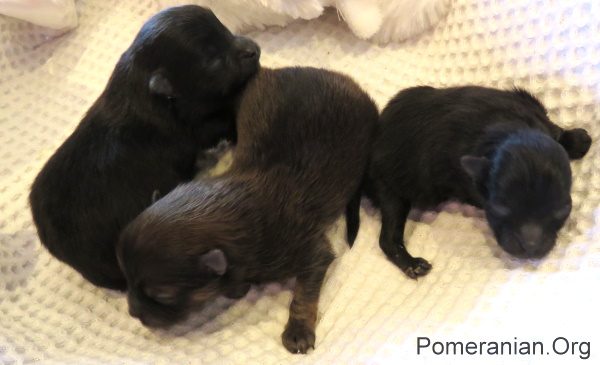
If you know she’s close to birthing time, ensure she’s in her comfortable whelping box. Don’t allow the sire or other dogs anywhere near her enclosure. Her cervix will dilate as contractions start.
This time may be uncomfortable and/or extremely painful. She may feel restless, pace up and down, start panting and shivering, and could even cry. She may not feel like food and she possibly may vomit. This initial stage is the longest, lasting anywhere from 4 – 12 hours.
Pomeranian Giving Birth Stage 2
Each puppy is encased in an amniotic sac that may break just before the pup is born or as he’s coming out. Each puppy can take 10 – 30 minutes of straining to push it out. Some come out sideways or feet coming out first.
If his back legs are sticking out but he’s not actually coming out, gently grasp him with a face washer, don’t pull, but as the bitch strains maintain a little pressure. Petroleum jelly can also be smeared on the puppy to help delivery.
As each puppy comes out, the mother bites off its umbilical cord and licks him clean. It’s vital that she’s allowed to do this. The rough licking helps stimulate the puppy so he starts breathing and it also helps get its circulation working. The mother normally consumes the amniotic sacs and placenta.
Using dental floss, tie a piece around the cord about one inch from the puppy’s stomach. Then tie another piece 0.25 inches away from that first tied piece and towards the placenta. Cut the cord between these two pieces with sterilized scissors. The umbilical cord generally falls off within a week or so.
Pomeranian Whelping Stage 3
After every puppy has been finally born, the mothers should settle and relax while allowing the pups to suckle. Allow the dam to remain close to the litter while you clean up. Let the mother eat one placenta. Allowing her to eat more may result in her developing diarrhea.
Always stay with the mother while she eats the placenta as Pomeranian females have choked and died while eating it.
Caring for Pomeranian Mother Dogs After Giving Birth
After giving birth, there may be a light discharge and very minor bleeding after whelping for a maximum of 10 days. It’s regarded as normal as long as it reduces each day and you can’t see any health problems.
However, it’s critical that you urgently take your Pom to the vet if:
- She has a fever.
- The bleeding gets worse day by day.
- There’s too much blood.
- The dam isn’t eating.
- The discharge and/or blood has a rank smell.
- Other signs of poor health are observed.
Pomeranian Care After Whelping Puppies
All soiled bedding should be removed and fresh bedding needs to be put in her safe haven. Place a heating pad under the blankets. Inside the whelping box, some parts should be warm 25-28° Celsius so puppies can move from a warm spot to a cool one if they feel too hot.
The whelping box’s flap should be shut so mothers and puppies feel secure and safe. It’s essential to monitor all of the puppies. If one can’t get sufficient milk from his mum, you’ll need to step in and feed him with a bottle. You may need to reposition puppies so they can get better access.
Weigh every puppy each day to ensure their weight increases daily. A set of kitchen scales is ideal for this purpose.
Put a soft cloth on the scale and put each puppy in it. If the puppies are very similar in color, you may have to use liquid paper and put a dot in a different part of their body to correctly identify each one.
Newborn Pomeranian Tips
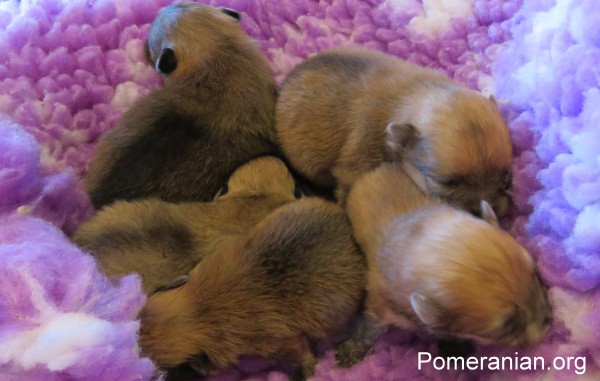
If the newborn Pomeranian puppies aren’t gaining weight every day, ring your vet urgently as there’s likely to be an unforeseen problem. Check the puppies for hypoglycemia as this can come on rapidly.
They must be checked hourly for the first week, every second hour for weeks 2 and 3, and every three hours for the fourth week.
Once week four arrives, you’ll need to give the mother a few breaks from her litter. Some recommend a second box be added to her whelping box.
Cut a “doorway” between both boxes so the puppies can enter the “playroom” and discover the world of toys.
Problems After Pomeranian Whelping?
If this question is on your lips, there’s usually a reason. Whether it’s changes in behavior or maybe something physical, take her to your vet or a nearby animal hospital as a matter of urgency.
Apart from very minor bleeding which is a normal process, there aren’t any other problems that would be regarded as “normal.”
Abnormal Problems After Pomeranian Whelping Include:
- Pain.
- Vomiting.
- Being aggressive or biting you.
- A pus discharge.
- Limping whenever she walks.
- Ddehydration (signs may include – dizziness, poor appetite and eyes that appear to have sunk in).
- Anything else that immediately rings alarm bells.
Final Thoughts on Pomeranian Pregnancy Stages
Breeding Pomeranian dogs can be difficult and stressful and is not something that should be entered into lightly.
I’m deeply saddened at the number of owners who write and ask if a certain problem is normal when their immediate course of action should be an urgent trip to their vet or pet hospital.
DON’T write to me or check out online animal communities to seek advice if your Pom has given birth and is still in a lot of pain. You won’t get a reply that’s fast enough because hundreds of people do the same thing. You’re potentially risking the life of your beloved Pom by doing so.

Copyright Pomeranian.org. All Rights Reserved.
References and Further Reading:
[1] Denise Leo “The Pomeranian Handbook”.
Disclaimer: The Content is not intended to be a substitute for professional veterinarian advice, diagnosis, or treatment. Always seek the advice of your veterinarian with any questions you may have regarding the medical condition of your dog. Never disregard professional advice or delay in seeking it because of something you have read on ANY website.








